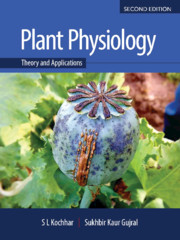Book contents
- Frontmatter
- Contents
- Foreword
- Preface to the Second Edition
- Preface to the First Edition
- Acknowledgements
- Some Common Abbreviations used in the Text
- Abbreviations for Units
- Unit I Water and Mineral Translocation in Plants
- Unit II Metabolism and Bioenergetics
- Unit III Growth and Development
- Unit IV Physiological Stress and Secondary Metabolites – Their Role in Metabolism
- Unit V Crop Physiology – An Innovative Approach
- Unit VI Breakthroughs in Plant Physiology
- Unit VII Some Experimental Exercises
- Glossary
- References
- Index
- Colour Plates
Chapter 15 - Plant Photoreceptors
Published online by Cambridge University Press: 12 May 2020
- Frontmatter
- Contents
- Foreword
- Preface to the Second Edition
- Preface to the First Edition
- Acknowledgements
- Some Common Abbreviations used in the Text
- Abbreviations for Units
- Unit I Water and Mineral Translocation in Plants
- Unit II Metabolism and Bioenergetics
- Unit III Growth and Development
- Unit IV Physiological Stress and Secondary Metabolites – Their Role in Metabolism
- Unit V Crop Physiology – An Innovative Approach
- Unit VI Breakthroughs in Plant Physiology
- Unit VII Some Experimental Exercises
- Glossary
- References
- Index
- Colour Plates
Summary
The receptor molecules used by plants to detect sunlight are termed photoreceptors. Photoreceptors absorb a photon of a particular wavelength and utilize this energy, thus initiating a photoresponse. All the known photoreceptors (except UVR8) consist of proteins bound to non-protein light-absorbing prosthetic groups (chromophores). Protein structures of the different photoreceptors vary and are involved in regulation of downstream signalling. Other common aspects of photoreceptors include sensitivity to light (quantity, quality, and intensity) and the time duration of the photoperiod. Photoreceptors, including phytochromes, cryptochromes and phototropins, help plants regulate developmental processes over their lifetime by sensitizing them to incident light. They also initiate protective processes in response to harmful radiations.
The action spectra of light-regulated responses demonstrate that plants are highly sensitive to UV-B radiation (280–320 nm), UV-A radiation (320–380 nm), blue light (380–500 nm), red light (620–700 nm), and far-red light (700–800 nm). UV-B radiation is detected by the UV RESISTANCE LOCUS 8 (UVR8) protein; UV-A and blue light, by cryptochromes, phototropins, and the recently discovered ZEITLUPE (ZTL) family; and red and far-red light by phytochromes. Zeitlupes are light-responsive F-box proteins that target proteins functioning in the circadian rhythms and the photoperiodic regulation of flowering. Phytochrome and cryptochrome are soluble receptors that function primarily in the nucleus to regulate the activity of transcription factors. These two classes collectively regulate developmental responses to light intensity and also mediate responses to variations in the spectral quality of light that indicate shading by other plants.
Phytochrome
Historical background: The discovery of a ubiquitous plant pigment, the phytochrome, and the evidence that it regulates almost every aspect of a plant's response to light was a path-breaking discovery for plant science. The domino effects of their historic research have been stupendous, which prompted scientists worldwide focusing on phytochrome-related research. The United States Department of Agriculture (USDA), Beltsville Agricultural Research Center (BARC) in Beltsville, Maryland, USA, was recently nominated an American Chemical Society National Historic Chemical Landmark for the seminal work of USDA scientists in the discovery of phytochrome.
- Type
- Chapter
- Information
- Plant PhysiologyTheory and Applications, pp. 453 - 467Publisher: Cambridge University PressPrint publication year: 2020



